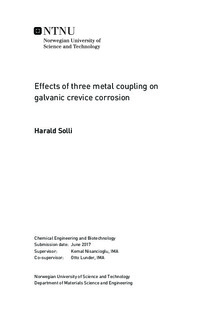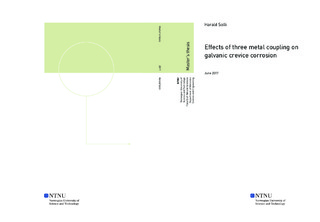| dc.description.abstract | The subsea industry is moving its operations down onto the seabed. With this new direction in production solutions a larger emphasis is placed on reducing the weight of the components in the production unit. Finding alternative material solutions to carbon steel in the structures is of high interest, where aluminium might be a fitting solution. A problem with this is that aluminium will experience galvanic corrosion when coupled to steel. Since not all of the steel components can be replaced, the metals will have to be isolated. A different solution could be to apply cathodic protection on both metals by use of a common sacrificial anode.
The purpose of this thesis was to investigate the effects of a three metal coupling on crevice corrosion. Especially aluminium has been found to have poor corrosion properties in galvanic coupling with a crevice present. Experiments were performed with X65 carbon steel and 6005 aluminium. The sacrificial anode for the steel-aluminium coupling were an AlZnIn sacrificial anode. The experiments were performed in synthetic seawater at both 25ºC and 10ºC. Some parallels was performed without the anode. The tests was a simulation of crevice corrosion with a crevice of 100μm and tests duration varied between 72,96 and 120 hours. After electrochemical measurements the metal surfaces were inspected and weight loss measurements were performed.
It was found that cathodic protection of steel-aluminium galvanic couples seems possible in galvanic crevice corrosion. Both metals experienced a reduction in current demand as a function of time during the experiments. Reduction rate on steel was found to be 1-2 orders of magnitude higher on steel than on aluminium. Aluminium experienced an anodic current initially which indicates corrosion. It was presumed to be due to development of an alkaline environment inside the crevice. The anodic current decayed with time and passed into the cathodic region for some of the parallels. The electrochemical behaviour were found to be promising for both metals.
Photographs together with SEM micrographs showed that the corrosive attack on aluminium occurred at the crevice mouth during the 25ºC tests. When the temperature was lowered to 10ºC the attack was found over the entire exposed surface. For steel, no corrosive attack was found at 25ºC. This was changed when the temperature was lowered and a small corrosive attack was found. Calcareous deposits were also investigated and found to form faster with the AlZnIn anode. Inspection and images indicated that these calcareous deposits could possibly block the crevice when the anode was connected to the system.
The weight loss measurements revealed complete protection of the steel at 25ºC and minor corrosion was found at 10ºC. It was concluded that the steel is well protected in the three metal coupling. Mass loss rate on aluminium was found to slow down as the duration of the experiments increased. It was concluded that protection of aluminium is possible, but that further testing is necessary. | |

